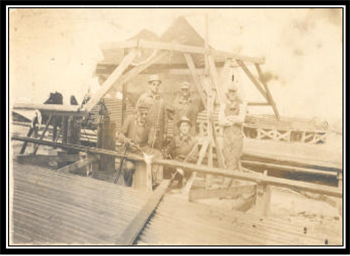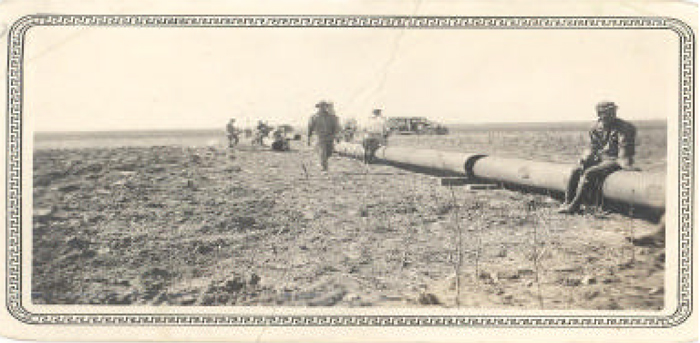The History of Pipefitters Local #208
By Dennis DeMaio, Vice President, National Writers Union
With information contributed by: James Hague Jr., Don Redmond, Don Groomer
One hundred years of pride, skill and solidarity in the labor movement
To understand and appreciate the history of Pipefitters Local #208, it is necessary to comprehend the conditions and economic environment pipefitters operated under in the latter part of the 1800s. As the economy of our nation was being rapidly transformed into a system of mass industrialization, piping of all kinds became a fundamental ingredient of the infrastructure of our country. From the steam engines that powered the factories to the public water systems that delivered safe drinking water to our homes, piping became the industrial veins holding our economy and health together. Through these industrial veins flowed the energy, steam, fuels and fluids that powered us to prosperity.
Behind the pipe is the story of a proud and hard working people who toiled under very difficult circumstances to assemble this great infrastructure. The skill, sweat and determination these workers poured into their jobs helped us build a great nation.
Keenly aware of the dignity and value of their work, these pipefitters helped to build more than a great industrial nation. With other hard working people in their communities, these pipefitters were primary catalysts in building the American labor movement. Embedded with the beliefs that all work has dignity and all workers are brothers and sisters, these pipefitters demonstrated time and time again their
commitment to the Americ an working class.
Conditions in the early years
 In the period preceding the formation of Local 208, conditions for pipefitters were very difficult for workers in the industries. Although wages in this skilled craft was above those of the average workers of the time, work projects were short-term and sporadic. The normal pipefitter considered eight months of pipefitting work a good year. Many pipefitters worked only six months of the year in the craft, and twelve months of steady work was almost unheard of.
In the period preceding the formation of Local 208, conditions for pipefitters were very difficult for workers in the industries. Although wages in this skilled craft was above those of the average workers of the time, work projects were short-term and sporadic. The normal pipefitter considered eight months of pipefitting work a good year. Many pipefitters worked only six months of the year in the craft, and twelve months of steady work was almost unheard of.
The average pipefitter in the Denver area in the second half of the 1800s was between twenty and forty years of age. He was likely to come from a working class family with limited educational backgrounds. Many pipefitters had no more than an eighth- grade education, which was typical of the educational level of working class families of the time.
Survival and steady work were what preoccupied the minds of pipefitters of the era. They struggled to keep their craft skills up to date because that was critical to remain gainfully employed in the work projects of the era. In the Denver area, these projects included hospitals, water delivery and treatment plants, schools, sewage plants and a variety of other projects.
Since jobs in the industry were short-term and sporadic, many pipefitters had to travel from region to region to remain gainfully employed in their craft. This created the need for a system of recognizing the qualifications, skills and aptitude of these pipefitters and plumbers who sought work throughout the country. Ultimately, this need was one of the primary forces contributing to the formation of a national trade union association in the pipe trades.

Early roots of trade unionism in the pipe trades
Trade unionism in the pipe trades can be traced back as far as the Jacksonian period in American history. In 1835, a group of pipe trade unions in Philadelphia conducted a strike to secure a ten- hour workday. Although a number of unions existed in larger cities like New York, Philadelphia and Chicago, there is no evidence of any attempt at the time to form a national union to help resolve problems in the pipe trades.
During the latter part of the Civil War period, trade unionism in the pipe trades increased dramatically. The emerging unions, however, remained scattered throughout the country and had little cooperation with or connection to one another.
As these scattered unions joined or were organized by the Knights of Labor (the precursor of the American Federation of Labor), they began to appreciate the need for some type of national organization. Although a series of plumbers, steam fitters and gas fitter unions petitioned the Knights of Labor for a national trade assembly charter in 1884, the Knights of Labor impeded the formation of this national association. Only fifteen years in existence at the time, the Knights of Labor was still evolving and reexa mining the feasibility of national trade assemblies within the organization.
Because of the confusion and delay on the application of a charter in the pipe trades, the International Association of Journeymen Plumbers, Steam Fitters and Gas Fitters (IA) established itself as an independent international union in 1885. The history of the IA was beset with problems. A bitter defeat in a strike in New York City and an enormous amount of the IA’s resources spent on a cooperative venture in Milwaukee contributed to the demise of the IA. Although the IA would continue in existence for years to come, it never developed into an effective organization that could represent the collective interests of plumbers, pipefitters and other workers in the pipe trades.
At the same time a national organization in the pipe trades was faltering, the pressing need for some type of organization to protect workers in the trade was growing. In Denver and other cities in the late 1880s, the industries were stepping up their use of subcontracting to undercut unions. There was also a pressing need to control entry into the craft by establishing some minimum standards and qualifications to protect wages. It also became critical to develop some type of system to accommodate the needs of traveling craft members in the industry. Since projects were short-term and sporadic in any geographical vicinity, brothers in the trade moved from city to city in search of work. Workers needed a system of certification so employers would recognize the craftsmanship of these skilled workers.
The birth of the United Association
It is impossible to understand the history of Local 208 without discussing the formation of the first effective national trade union in the pipe trades. During the 1880s, workers in the pipe trades throughout the country, including Denver, were keenly aware of the need for a national organization to protect workers in the industry. It is in this environment that a Boston plumber, P.J. Quinlan, wrote a letter on April 25, 1889 to Richard A. O’Brien, a plumber in Washington D.C. Mr. Quinlan wrote:
“Dear Sir and Brother:
I take the liberty of addressing a few lines to you to obtain your views as regards the formation of a
United Brotherhood….”
The “view” to form a national trade union in the pipe trades quickly spread like a wildfire throughout the country. The moment was ripe. Within months, 40 delegates representing 23 independent unions in 10 states and the District of Columbia met in Washington D.C. to advance the initiative. On October 7, 1889, these delegates formed the United Association of Journeymen Plumbers, Gas Fitters, Steam Fitters’ Helpers of the United States and Canada (the United Association). Among the first elected officers and officials were:
President: Patrick J. Quinlan (Boston)
Vice President: Henry Collins (New York City)
Sec’t. Treas.: Richard A. O’Brien (Washington D.C.)
2nd Vice President: H.D. McGahn (Denver)
Executive Board Member: E.J. McNamara (Denver)
Two pipe trade brothers from Denver were among the leadership ranks that forged the first successful national organization of the pipe trade unions in North America. From those 40 delegates in 1889, the UA has grown into a powerful organization of almost 300,000 highly skilled members who belong to 418 individual local unions across North America. It remains one of the most respected and influential building trade unions in North America today.
Next Page